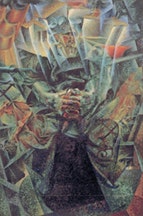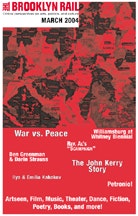ArtSeen
Boccioni’s Materia
A Futurist Masterpiece and the Avant-garde in Milan and Paris
Solomon R. Guggenheim Museum

Futurism is what often comes to mind when people try to imagine modern painting: a demolition derby of figures and forms, planes and colors, text strips and musical notations, smokestacks, cut-up buildings, speeding trains, and automobiles. It’s the art of the century of Einstein, Marconi, Kropotkin, of better living through chemistry, travel, and education, of the New! Futurist painters were revolutionary, bearing dense manifestoes written by tough partisan intellectuals.
But the Future ended in 1916, when Umberto Boccioni fell off his horse and died during a cavalry exercise at age thirty-four. He was a handsome, dapper, very funny guy, and an enormously talented painter and sculptor. Just four years earlier he had painted the mother of all mother paintings, "Materia" (1912), and it can now be seen at the Guggenheim Museum, along with twenty-three other terrific paintings, sculptures, and drawings. Boccioni’s work is accompanied by works by Balla, Picasso, Braque, Gris, Gleizes, Léger, Delauney, and Duchamp’s "Nude Descending a Staircase (No. 2)" (1912). It is a lean but important exhibition, nicely installed by Laura Mattioli Rossi, guest curator, and Vivien Greene, Guggenheim Associate Curator.
The Future began in 1909 when Filippo Tommaso Marinetti, a Milan millionaire, verse liberator, and publisher of Poesie magazine hung out his newest shingle on the front page of Le Figaro: "The Manifesto of Futurism." "We declare," it read in part, "that the world’s wonder has been enriched by a fresh beauty; the beauty of speed… because we want to deliver Italy from its gangrene of professors, archaeologists, guides, and antiquarians… Set the Library stacks on fire! Turn the canals in their course to flood the museum vaults! There go the glorious canvases, floating adrift.… We hurl our challenge to the stars!" "We" was one. Marinetti. Soon, however, a small group of anarchist Divisionist painters who had studied with Giacomo Balla (of the twenty-legged puppy) showed up to sign on. They began turning out a significant number of manifestoes, and held evenings, "seratas," espousing the new movement, at the end of which the audience usually pelted them with rotten food.
Divisionism was a technique of painting in which form was broken up into strokes of separated and contrasting color, derived from Seurat’s experiments with pointillism. Boccioni traveled to Paris for the first time in 1902, where he met Gino Severini, who introduced him to Balla. Severini was to write in his autobiography, "We were extremely fortunate to meet such a man [Balla]…The state of Italian painting at that time was one of the muddiest and most injurious imaginable." In 1911 Severini would bring the Milanese Divisionists to Paris once again, at Marinetti’s expense, this time to meet his friends Picasso, Braque, Gris, and Apollinaire. Cubism had been invented and he wanted the Italian painters to see it. For Boccioni the combination of Cubism and Divisionism would be a brilliant marriage. And Marinetti’s outrageous evenings and manifestos on every subject from education to aphrodisiacs (Marinetti’s Futurist aphrodisiac cocktail, according to Colin McIntosh: pineapple juice, cocoa, red peppers, nutmeg, caviar, cloves, eggs) were perfect publicity for the movement from New York to Moscow.
The centerpiece of the Guggenheim exhibition, "Materia" is a brilliant, weird, heaving masterpiece that grew in size as Boccioni painted it. (Three strips of canvas were added to the bottom and one to the top to make an eighty-nine inch high rectangle from a fifty-nine inch square canvas.) It’s his mother, but Whoa! The painting begins as an echo of Masaccio’s "Madonna Enthroned" (1426). But Boccioni then proceeds to create the Great Mother Goddess: devourer, guardian of the underworld, Mata,Kali, Am-mit, Hathor. Mountains make their own weather, create their own lightning and storms. "Materia" is such a mountain. Lightning plays at the peak, generated in the clasp of powerful, encircling arms; the eternal vessel of fire, the hidden temple. "Materia" is a combine title, a word made out of the title of Henri Bergson’s Matter and Memory. He was a favorite author of the Futurists, of Boccioni in particular, who remembered Bergson best for his notion of "élan vital," which Star Wars fans know as "the Force."
Boccioni wanted to bring the viewer "into the center" of his painting. (So did Carra, and there was much argument between the two as to whose idea it originally was.) "Materia" does if you let it. Sharing certain qualities with Jay DeFeo’s "The Rose" (1958-66), both artists are aggressively ravishing. The central focus of "Materia" is the mother’s huge hands, clasped, at rest. She seems exhausted, yet ridges of electricity run from her thumbnails up massive arms, escaping in an aurora of lights surrounding her receding head and body. Folds of clothing blend with the ironwork of the balcony where she sits. Behind are the billowing smokestacks and interpenetrating forms of the city, pulled to the foreplane of the painting by effects of reflection: Boccioni is looking at her through a window, on the inside. Reds, blacks, greens, yellows, and blues glow like the furnace of a steel mill. The painting becomes a work of alchemy. The red-hot ghost of a horse gallops across the figure’s left knee, a weird reminder of the painter’s death, and another red ghost figure, a reflection of a figure on the street below, strides across the right knee in the opposite direction. The following year this figure will become sculpture in "Unique Forms of Continuity in Space."
Otherwise, Boccioni is always talented and stylish. De Kooning liked his work; you can see Boccioni’s influence on him scattered throughout, especially in the drawings. Mondrian was a fan as well. Boccioni takes up Matisse’s theme of the fusion of external and internal space in "The Street Enters the House," a 1911 painting measuring one-meter square. It is a painting of barely controlled chaos. Milan was not Rome or Florence, inviolate in their past glory. Milan was industrial, and it was expanding rapidly. As with Courbet and Pissarro, the worker was entering the subject of painting.
In an enlarged photo of an early plaster version of "Unique Forms of Continuity in Space" (now destroyed), one can see that Boccioni quickly moved beyond the Duchampian "flip-book" approach to creating movement through multiple partial views of arms, legs, and bodies, and adopted a "dynamic" stylistic solution to the problem. The aquatic-looking forms attached to the forty-eight inch high bronze version of the subject are an attempt to suggest disturbance of space/time as the figure mutates through the act of movement. Boccioni’s private Futurism was an act of heightened perception, a visual equivalent to the "persistence of vision," a kind of stroboscopic cinema. It works even more powerfully in his small, but monumental "Development of a Bottle in Space" (1912). Severini informs us that Boccioni achieved his mastery of sculpture in just twelve months of work, exhibiting ten sculptures and twenty drawings at Galerie La Boetie in Paris and Rome in 1913.
Once Futurism embraced Cubism, it appeared everywhere at the same time, in 1911, in New York as Synchronism, in London as Vorticism, in Moscow as cubo-futurism, in Paris as Orphism ("The new empty word that they can stick up their…" said Boccioni in 1912). As the century progressed, it faded, evolving into other movements. Yet modernist abstraction persists in our cultural psyche. I’ll always remember an art teacher when I was in junior high school, who gave her class the assignment: "Make a painting of Time."




